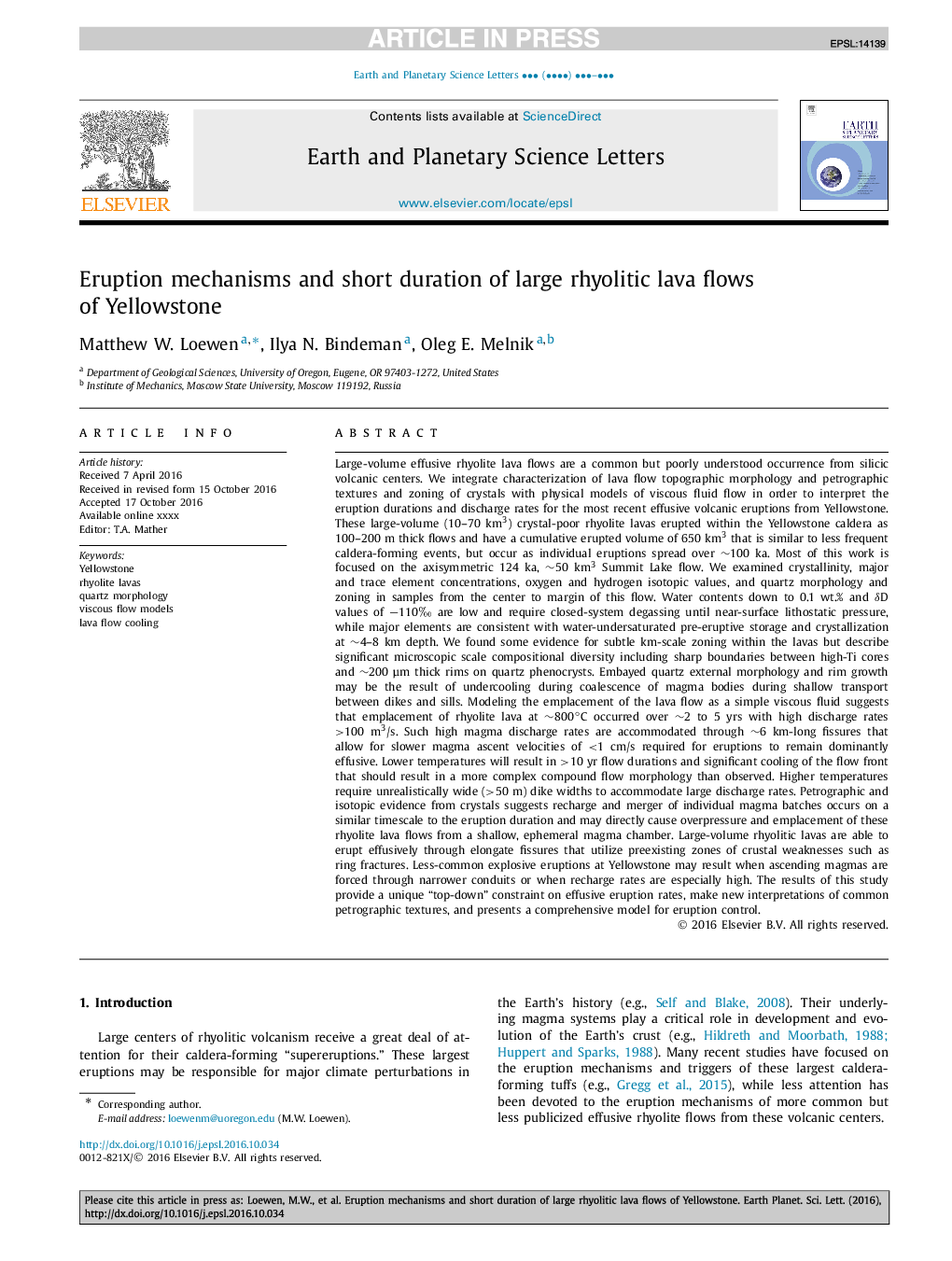| کد مقاله | کد نشریه | سال انتشار | مقاله انگلیسی | نسخه تمام متن |
|---|---|---|---|---|
| 5780004 | 1634698 | 2017 | 12 صفحه PDF | دانلود رایگان |
عنوان انگلیسی مقاله ISI
Eruption mechanisms and short duration of large rhyolitic lava flows of Yellowstone
ترجمه فارسی عنوان
مکانیزم تخریب و مدت کوتاهی جریانهای گدازه ای بزرگ یلوستون
دانلود مقاله + سفارش ترجمه
دانلود مقاله ISI انگلیسی
رایگان برای ایرانیان
کلمات کلیدی
یلوستون، لیوهای ریولیت، مورفولوژی کوارتز، مدل های جریان چسبناک، خنک کننده جریان گدازه،
موضوعات مرتبط
مهندسی و علوم پایه
علوم زمین و سیارات
علوم زمین و سیاره ای (عمومی)
چکیده انگلیسی
Large-volume effusive rhyolite lava flows are a common but poorly understood occurrence from silicic volcanic centers. We integrate characterization of lava flow topographic morphology and petrographic textures and zoning of crystals with physical models of viscous fluid flow in order to interpret the eruption durations and discharge rates for the most recent effusive volcanic eruptions from Yellowstone. These large-volume (10-70 km3) crystal-poor rhyolite lavas erupted within the Yellowstone caldera as 100-200 m thick flows and have a cumulative erupted volume of 650 km3 that is similar to less frequent caldera-forming events, but occur as individual eruptions spread over â¼100 ka. Most of this work is focused on the axisymmetric 124 ka, â¼50 km3 Summit Lake flow. We examined crystallinity, major and trace element concentrations, oxygen and hydrogen isotopic values, and quartz morphology and zoning in samples from the center to margin of this flow. Water contents down to 0.1 wt.% and δD values of â110â° are low and require closed-system degassing until near-surface lithostatic pressure, while major elements are consistent with water-undersaturated pre-eruptive storage and crystallization at â¼4-8 km depth. We found some evidence for subtle km-scale zoning within the lavas but describe significant microscopic scale compositional diversity including sharp boundaries between high-Ti cores and â¼200 μm thick rims on quartz phenocrysts. Embayed quartz external morphology and rim growth may be the result of undercooling during coalescence of magma bodies during shallow transport between dikes and sills. Modeling the emplacement of the lava flow as a simple viscous fluid suggests that emplacement of rhyolite lava at â¼800â°C occurred over â¼2 to 5 yrs with high discharge rates >100 m3/s. Such high magma discharge rates are accommodated through â¼6 km-long fissures that allow for slower magma ascent velocities of <1 cm/s required for eruptions to remain dominantly effusive. Lower temperatures will result in >10 yr flow durations and significant cooling of the flow front that should result in a more complex compound flow morphology than observed. Higher temperatures require unrealistically wide (>50 m) dike widths to accommodate large discharge rates. Petrographic and isotopic evidence from crystals suggests recharge and merger of individual magma batches occurs on a similar timescale to the eruption duration and may directly cause overpressure and emplacement of these rhyolite lava flows from a shallow, ephemeral magma chamber. Large-volume rhyolitic lavas are able to erupt effusively through elongate fissures that utilize preexisting zones of crustal weaknesses such as ring fractures. Less-common explosive eruptions at Yellowstone may result when ascending magmas are forced through narrower conduits or when recharge rates are especially high. The results of this study provide a unique “top-down” constraint on effusive eruption rates, make new interpretations of common petrographic textures, and presents a comprehensive model for eruption control.
ناشر
Database: Elsevier - ScienceDirect (ساینس دایرکت)
Journal: Earth and Planetary Science Letters - Volume 458, 15 January 2017, Pages 80-91
Journal: Earth and Planetary Science Letters - Volume 458, 15 January 2017, Pages 80-91
نویسندگان
Matthew W. Loewen, Ilya N. Bindeman, Oleg E. Melnik,
